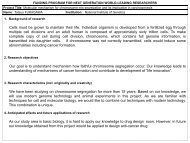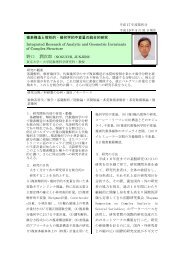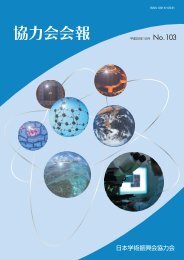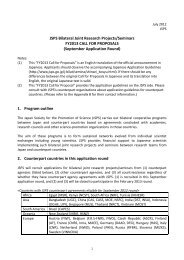"JSPS External Review Report" was issued.(PDF File 1.22MB)
"JSPS External Review Report" was issued.(PDF File 1.22MB)
"JSPS External Review Report" was issued.(PDF File 1.22MB)
You also want an ePaper? Increase the reach of your titles
YUMPU automatically turns print PDFs into web optimized ePapers that Google loves.
This program sought to improve and strengthen Japan’s pool ofpost-doctoral researchers, shallow compared to the US and Europe, andestablish this research experience as an important step in a researcher’scareer path as a means of honing researchers’ abilities and setting in place amechanism whereby these researchers play a more significant R&D role. It<strong>was</strong> therefore decided to strengthen Japan’s research development capacity,create an environment in which researchers could focus on their researchdevelopment activities, foster and secure the human resources underpinningresearch development, and develop systems allowing the use of externalsupport functions. The goal <strong>was</strong> established of supporting 10,000postdoctorals by 2000.Various programs were subsequently implemented, including <strong>JSPS</strong>programs for fostering researchers (Fellowship Program, PostdoctoralFellowships for Foreign Researchers, and Postdoctoral Fellowships forResearch Abroad), the research associates appointed under the <strong>JSPS</strong>Research for the Future Program, the part-time researchers in nationaluniversity Centers of Excellence, STA Fellowships supported by the JapanScience and Technology Corporation (integrated into the <strong>JSPS</strong> program as of2002), and Core Research for Evolutional Science and Technology (CREST)set up by the Japan Science and Technology Corporation. As a result, the10,000 postdoctoral goal <strong>was</strong> reached in FY1999. The Program to Support10,000 Postdoctorals has therefore created a greater pool of young Japaneseresearchers and contributed to stimulating the research environment, butissues remain in terms of, for example, relationships with researchsupervisors during the postdoctoral period, and career paths after thepostdoctoral period has ended. Other systemic improvements have beenmade, such as relaxation of regulations on the dual employment of civilservants to promote university-industry cooperation, and the introduction ofa fixed tenure system, but there is still much room for improvement interms of increasing the current mobility of human resources.Role of foreign students and researchersBased on two sets of recommendations from emine ntpersons, ”Recommendations for Foreign Student Policy toward the 21 stCentury” (1983) and “Developing Foreign Student Policy in the 21 st158







